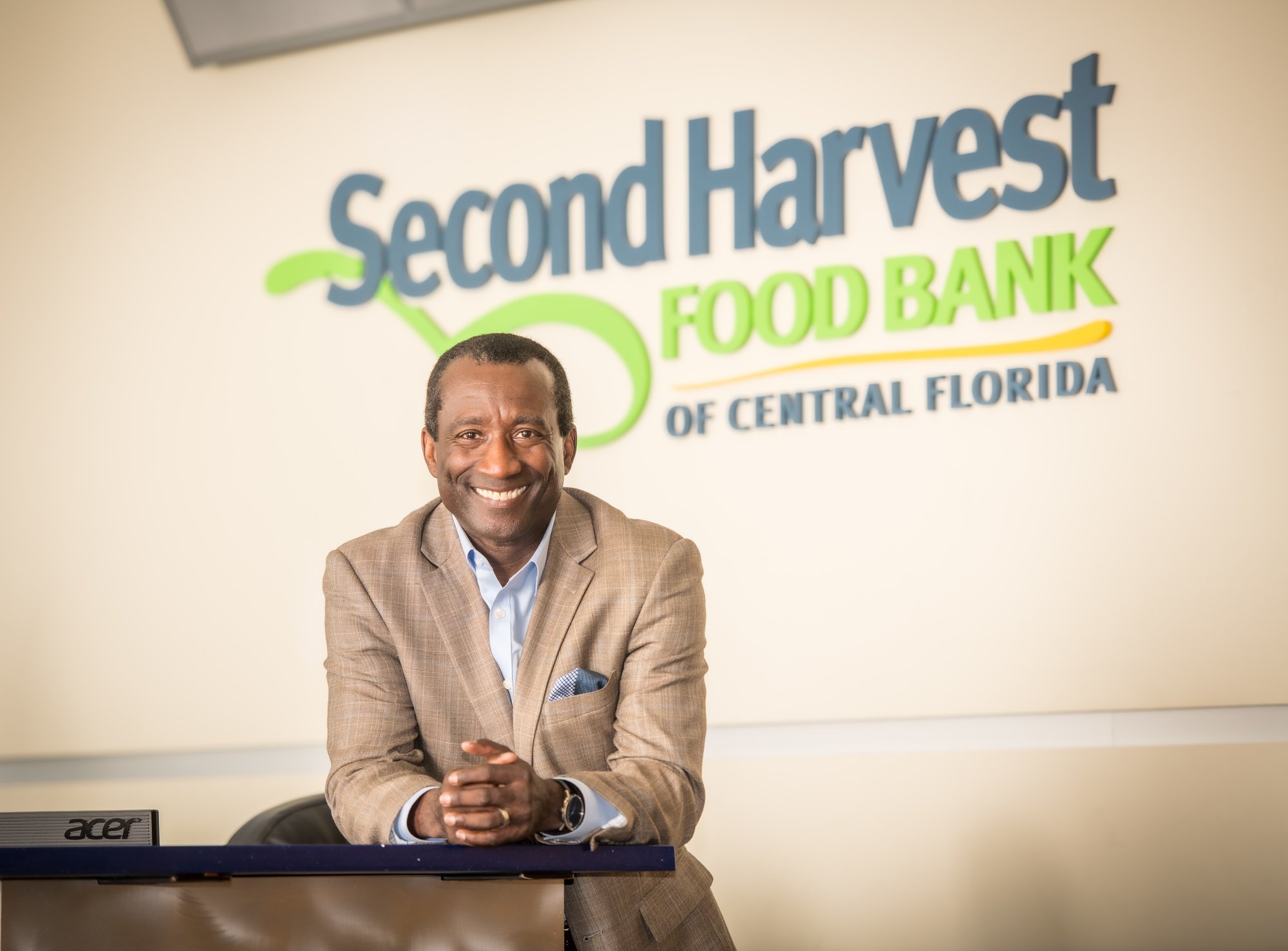
Behind the Scenes of Central Florida's Second Harvest Food Bank
Elaine Acker
When I interviewed Derrick Chubbs, CEO of Central Florida’s Second Harvest Food Bank, I had no idea that when we released this two-part podcast episode and blog, Florida would be recovering from hurricanes Helene and Milton, placing in an even bigger responsibility squarely on the shoulders of the region’s food pantries.
Derrick and I previously worked together at the American Red Cross, and we both understand how disruptive natural disasters can be. In this conversation, Derrick, shares his perspective on the role of food banks, the challenges they face, and the incredible impact they make in their communities.
I asked Derrick how his time spent in disaster response prepared him for his roles with the Central Texas Food Bank, and then with Second Harvest in Florida. “I thought it had prepared me better than it actually had, in all honesty,” he says. “The logistics components, trucks, the dependence on volunteers…those were valuable. But learning the intricacies of everything from supply chain management to distribution required a whole other level of expertise.”
Food banks across the country play very active roles in disasters. “We have a partnership with the American Red Cross here in Central Florida just like we had in Central Texas,” says Derrick. “I had a little insight on how the Red Cross actually worked, so when it came to disaster, I was definitely the guy. I’m not sure that's what you want to be known for, but it made a difference.”
Navigating the Complexities of Food Acquisition and Distribution
While disaster response meets a critical need, Derrick emphasized that the food banks in their network are addressing ongoing hunger needs within communities every day.
“We’re dealing with more than 750 partner agencies,” says Derrick. “They range from large organizations with very sophisticated operations to the little bitty corner church pantry. They all have different needs, and that means we also need pretty sophisticated insights The top 50 partners literally distribute 75 percent of the 90 million pounds of food that we'll distribute this year.” All of this adds up to meticulous attention to quality standards, accountability, audits, and inspections.
Meeting the Growing Demand for Food
“When I transitioned to leading food banks, I was blown away by the numbers,” says Derrick. “I also realized I didn't know nearly as much as I thought I did about what our friends and neighbors are being challenged with on a day to day basis.”
When Derrick started as CEO of the food bank in Austin in 2017, the organization was distributing around 33 million pounds of food a year. Five years later, in 2022, they were distributing 69 million pounds and were still falling short of the demand. “That’s what I see happening here in Florida, too,” he says. “In 2019, right before the pandemic, Central Florida’s Second Harvest food bank was distributing around 150,000 meals a day. During the pandemic, that number went up to 300,000 meals a day and the numbers are still rising.” Derrick attributes this increase to factors such as the long-term effects of the pandemic, natural disasters, inflation, high interest rates, and stagnant wages.
“I have learned to put just about every challenge in some type of ‘disaster’ bucket, independent of the weather,” says Derrick. “If you don’t know where your next meal is coming from, that’s a disaster. If you can’t pay for childcare, that’s a disaster. If you can’t pay your rent, that’s a disaster.”
If you need help, or know someone who does, you can send them to the “Food Finder” page on the Second Harvest website. Simply enter your zip code and you will find a partner agency near you.
Inside the Second Harvest Culinary Program
The food bank is also involved in creative programs that have a direct impact on the community. “Second Harvest has a culinary program,” says Derrick. “It’s a It's a free, 16-week program that's focused on individuals who may have had barriers to employment. And we have a 96 percent placement rate.”
Derrick admits that being in Orlando, one of the country’s hospitality meccas helps. “Our graduates are very well trained and we not only teach them the technical aspects of how to navigate a kitchen, we also teach them conflict resolution and financial literacy. We teach them how to interview. I'll put one of our graduates up against any of my local schools that charge tuition any given day of the week.”
Eating Healthy
“Every last one of us know eating healthy has its benefits,” says Derrick. “But we haven't necessarily pushed it really hard at the food bank level. But that is changing and there are opportunities for significant partnerships with this. Second Harvest has two kitchens, and right now we are doing a pilot program with the DaVita Foundation with a primarily focus on kidney disease. We have 60 patients experiencing renal failure that we're preparing specific meals. Then we’ll track their repeat doctor visits (when we go back to the doctor the second, third, fourth, and fifth time for the same issue). We’re convinced that we can make an impact on that.
“We have another one coming up where we're going to focus purely on diabetes. There are initiatives like this going on across the country where we're saying the food bank can be a major factor in community health.
The Second Harvest team includes chefs and nutritionists, who are not only working on food solutions for clients with medical needs but are teaching individuals in local and surrounding counties how to prepare healthy meals.
Supporting Kids and Families
Those who need medically tailored meals aren’t necessarily the most vulnerable food bank clients. Last year, Second Harvest had backpack programs and weekend programs to provide a child with a meal for dinner after school or for the weekend. “We learned that many of kids were taking those little backpacks home and sharing that food with the family,” says Derrick. “Their families were hungry, too. So we ramped up a school pantry program in about 100 schools that expanded quickly with a major donation. Now, we’ve added more fruits and vegetables to it and parents can come and pick up groceries along with their kids.”
The school pantries are separate from the food bank’s partner agencies. “And you know what? In most of the cases that school pantry is run by the students,” says Derrick. “I have met the most amazing young men and women, sophomores, juniors, and seniors who manage the pantries. I call them the young philanthropists. They’re packaging all the food and they are learning about giving back and about service. They're also learning things about dignity and confidentiality, because, you know, kids can be cruel sometimes. And then there are new job skills. I mean, they're learning to be responsible.”
I was surprised to find out not all schools even have cafeterias. There are meal suppliers for those schools, and the food bank is contracted to provide some 4,000 meals a day.
“A meal is a right, it's not a privilege” says Derrick. “Statistically, each of us individually throws away about 20 pounds of food a month. And we throw away 40 percent of the food that we produce in this country. There is no reason for anybody to go without a meal. Yet, we have millions that go without a meal every single day in our country. And that I find is beyond tragic. I would love to work myself out of a job, but there's no indicator that that's going to happen anytime soon. Awareness is a great place to start.
Get Involved
Visit the Second Harvest Food Bank and find out how to volunteer your time and make a donation to help Central Florida’s communities recover from the devastation of Hurricane Milton and Hurricane Helene.
💡 What steps can you take in your own community to support local food banks and address issues of food insecurity?
And no matter where you live, your local food bank needs you, too. Visit feedingamerica.org and learn more about the hunger crisis in America and find your closest food bank. They’re playing a critical role in supporting vulnerable populations and fighting a very real fight against hunger.
Are you hungry?
If you’re struggling to pay all the bills and find yourself skipping meals, or giving up your meal for your kids, it’s okay ask for help! You can visit Feeding America, enter your zip code, and find the food bank nearest you nationwide!

